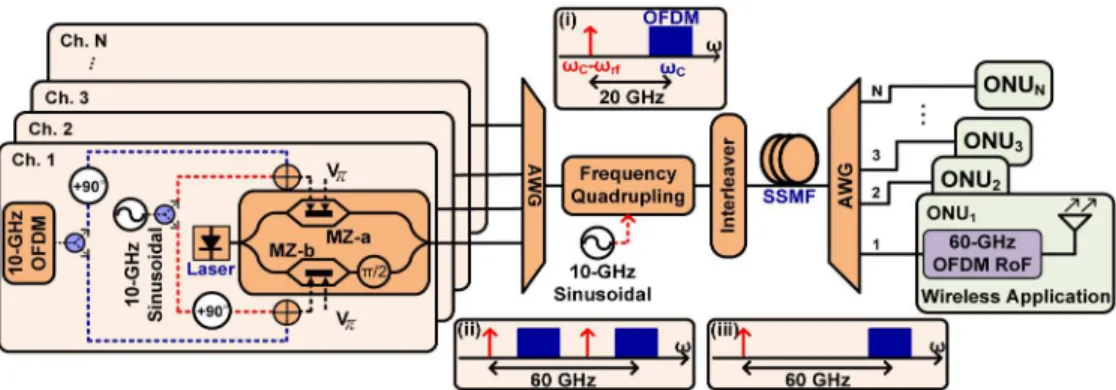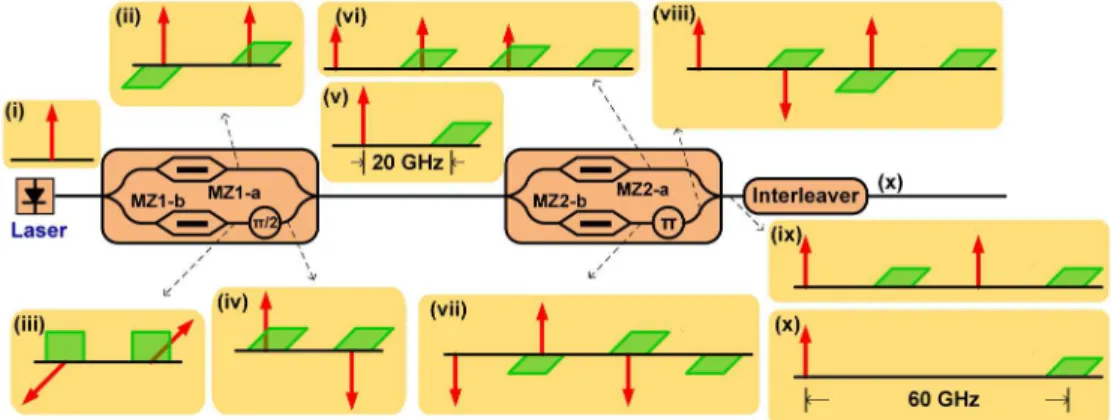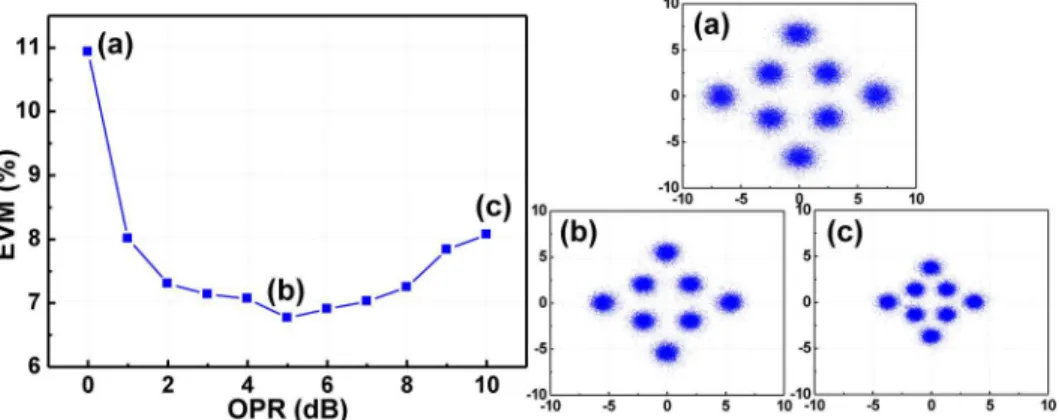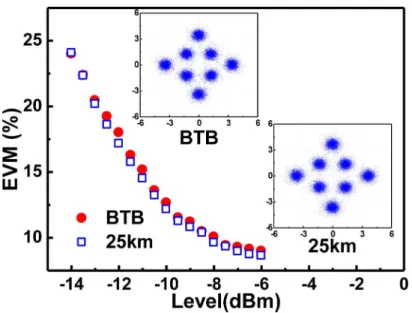Transmission of 20-Gb/s OFDM signals
occupying 7-GHz license-free band at 60 GHz
using a RoF system employing frequency
sextupling optical up-conversion
Po-Tsung Shih,1,3 Chun-Ting Lin,2,* Wen-Jr Jiang,1 Han-Sheng Huang,1Jyehong Chen,1 Anthony Ng’oma,3 Michael Sauer,3 and Sien Chi1,4 1 Department of Photonics and Institute of Electro-Optical Engineering,
National Chiao-Tung University, Hsinchu 300, Taiwan
2 Institute of Photonic System, National Chiao Tung University, Tainan 711, Taiwan. 3 Science and Technology Division, Corning Incorporated, Corning, NY 14831, USA
4Department of photonics engineering, Yuan-Ze University, Taiwan *jinting@mail.nctu.edu.tw
Abstract: This work describes a proposed 60-GHz radio-over-fiber (RoF)
system employing a frequency sextupling optical up-conversion scheme. Based on the modified single sideband modulation scheme, spectrally efficient vector signals were transmitted with no performance degradation due to dispersion-induced fading. Wavelength-division- multiplexed optical up-conversion can be realized using the proposed system. Since the required transmitter bandwidth is significantly reduced, radio-frequency components with lower bandwidth and higher reliability can be utilized. Both 13.75-Gb/s QPSK-OFDM and 20.625-Gb/s 8QAM-OFDM signals were experimentally demonstrated. After transmission over 25-km of standard single mode fiber, no significant received power penalty was observed.
©2010 Optical Society of America
OCIS codes: (060.2330) Fiber optics communications; (060.2360) Fiber optics links and
subsystems.
References and links
1. H. C. Chien, A. Chowdhury, Z. Jia, Y. T. Hsueh, and G. K. Chang, “60 GHz millimeter-wave gigabit wireless services over long-reach passive optical network using remote signal regeneration and upconversion,” Opt. Express 17(5), 3016–3041 (2009).
2. J. J. V. Olmos, T. Kuri, T. Sono, K. Tamura, H. Toda, and K. Kitayama, “Reconfigurable 2.5-Gb/s Baseband and 60-GHz (155-Mb/s) Millimeter-Waveband Radio-Over-Fiber (Interleaving) Access Network,” IEEE J. Lightwave Technol. 26(15), 2506–2512 (2008).
3. C. T. Lin, P. T. Shih, Y. H. Chen, W. J. Jiang, J. Chen, and S. Chi, “Experimental Demonstration of 10-Gb/s OFDM-QPSK Signal at 60GHz Using Frequency-Doubling and Tandem SSB Moudlation,” in Proc. Optical Fiber Communication Conf. (OFC), San Diego, OMV7 (2009).
4. M. Weiß, M. Huchard, A. Stöhr, B. Charbonnier, S. Fedderwitz, and D. S. Jäger, “60-GHz Photonic Millimeter-Wave Link for Short- to Medium-Range Wireless Transmission Up to 12.5 Gb/s,” IEEE J. Lightwave Technol.
26(15), 2424–2429 (2008).
5. Y. X. Guo, B. Luo, C. S. Park, L. C. Ong, M.-T. Zhou, and S. Kato, “60 GHz Radio-over-Fiber for Gbps Transmission,” Proceedings on Global Symposium on Millimeter Waves (GSMM), Invited paper (2008). 6. C. T. Lin, P. T. Shih, Y. H. Chen, W. J. Jiang, J. Chen, and S. Chi, “Experimental Demonstration of 10-Gb/s
OFDM-QPSK Signal at 60GHz Using Frequency-Doubling and Tandem SSB Moudlation,” in Proc. Optical Fiber Communication Conf. (OFC), San Diego, OMV7 (2009).
7. S. Geng, J. Kivinen, X. Zhao, and P. Vainikainen, “Millimeter-Wave Propagation Channel Characterization for Short-Range Wireless Communications,” IEEE Trans. Vehicular Technol. 58(1), 3–13 (2009).
8. C. T. Lin, S. P. Dai, J. Chen, P. T. Shih, P. C. Peng, and S. Chi, “A novel direct detection microwave photonic vector modulation scheme for radio-over-fiber system,” IEEE Photon. Technol. Lett. 20(13), 1106–1108 (2008). 9. C. Lim, M. Attygalle, A. Nirmalathas, D. Novak, and R. Waterhouse, “Analysis of optical carrier-to-sideband
ratio for improving transmission performance in fiber-radio links,” IEEE Trans. Microw. Theory Tech. 54(5), 2181–2187 (2006).
10. P. T. Shih, C. T. Lin, W. J. Jiang, J. J. Chen, H. S. Huang, Y. H. Chen, P. C. Peng, and S. Chi, “WDM up-conversion employing frequency quadrupling in optical modulator,” Opt. Express 17(3), 1726–1733 (2009).
11. W. R. Peng, X. Wu, V. R. Arbab, B. Shamee, J. Y. Yang, L. C. Christen, K. M. Feng, A. E. Willner and S.Chi, “Experimental demonstration of 340 km SSMF transmission using a virtual single sideband OFDM signal that employs carrier suppressed and iterative detection techniques,” in Proc. Optical Fiber Communication Conf. (OFC), San Diego, OMU1 (2008).
12. S. L. Jansen, I. Morita, and H. Tanaka, “Carrier-to-signal power ratio in fiber-optic SSB-OFDM transmission systems,” in Proc. Institute of Electronics, Information and Communication Engineers (IEICE) Conference 2007, B-10–24.
1. Introduction
With the rapidly growing demand for bandwidth, millimeter-wave (MMW) frequencies along with spectrally efficient modulation formats have become potential candidates for next generation broadband wireless communication systems. Thanks to the recently released 7-GHz licensed-free band, 60-7-GHz wireless communication has attracted a lot of attention to support multi-Gbps HDTV or uncompressed video transmission [1–5]. However, the transmission distance of the 60-GHz wireless signals is strongly restricted by the high path losses and for longer wireless transmission distances, the oxygen absorption [6]. To extend the 60-GHz wireless signal coverage, radio-over-fiber (RoF) technologies provide the most promising choice. However, the use of RoF systems to generate and transmit 60 GHz signals modulated with spectrally efficient modulation formats still remain a challenge [1–7].
Using electro-absorption-modulator (EAM) is one of the simple solutions because of the high bandwidth of EAM [5]. However, dispersion induced performance fading issue limits the transmission distance of 60-GHz RoF signals under 1-km in standard single mode fiber (SSMF) due to the generated double sideband (DSB) modulation scheme. Moreover, the need for 60-GHz components at the transmitter complicates signal processing and considerably increases the system cost. To reduce the bandwidth requirement of the transmission system, 60-GHz signal generations with frequency multiplication is highly desired. Double sideband with carrier suppression (DSB-CS) modulation scheme with frequency doubling using Mach-Zehnder modulators (MZM) has been proposed for 60-GHz RoF signal generation [1]. Although, the transmitter bandwidth is reduced and no dispersion induced performance fading is observed, radio-frequency (RF) components with frequency up to 30 GHz are still required. Moreover, only on-off-key (OOK) modulation format which has low spectral efficiency is usually utilized in DSB-CS systems [1,2,4].
To support the next generation multi-Gbps wireless communication system, a novel signal generation system for 60-GHz RoF links is proposed in this paper. Frequency sextupling with optical up-conversion of the transmitter was achieved by cascading a modified single sideband (SSB) signal generation system and a frequency-quadrupling optical up-conversion system. Compared with conventional OSSB modulation schemes, frequency doubling is achieved in the first stage of the proposed modified OSSB scheme, and frequency sextupling is achieved after the frequency quadrupling in the second stage. Therefore, the bandwidth requirement of the transmitter was reduced and only 10-GHz components are required. The modified SSB signal was generated from two individual driving signals [8]. No fiber dispersion induced performance fading issue, which is normally observed in conventional DSB modulation schemes was expected based on the SSB modulation scheme.
In conventional optical SSB modulation scheme, the optical power ratio (OPR) between the optical carrier and optical sideband is fairly high which leads to a limited optical modulation index (OMI) and reduces the receiver sensitivity. In the proposed system, the OPR between the LO and data modulated optical sidebands can be freely adjusted for receiver performance optimization [9]. This RoF system is capable of transmitting radio signals with high spectral efficiency, such as M-arry phase-shift keying (M-PSK), quadrature-amplitude-modulation (QAM), and orthogonal frequency-division multiplexing (OFDM) signals. Furthermore, based on the wavelength independent optical up- conversion system, wavelength-division-multiplexed multiplexing (WDM) up-conversion can be achieved [10]. A 13.75-Gb/s quadrature-phase-shift-keying OFDM (QPSK-OFDM) signal and a 20.625-Gb/s 8QAM-OFDM signal are employed to experimentally demonstrate the system capability. After transmission of 25-km SSMF, no significant received power penalty was observed.
Fig. 1. Conceptual diagram of the 60-GHz vector signal generation system with frequency sextupling.
2. Concept
Figure 1 shows the conceptual diagram of the 60-GHz vector signal generation system with frequency sextupling. The proposed system is composed of two up-conversion stages with two dual-parallel Mach-Zehnder modulators (DP-MZM). The first DP-MZM is utilized in the first stage to generate an optical single sideband with carrier suppression (SSB-CS) signal [8]. A local oscillator (LO) and an intermediate frequency (IF) vector data signal are combined to form a composite driving signal. After the first DP-MZM, an LO optical carrier is generated at the lower sideband and a data-modulated OFDM signal is generated at the upper sideband, as shown in the inset (i) of Fig. 1. Notably, frequency doubling is achieved after the first stage. The second stage is an optical up-conversion system which is composed of a wavelength-independent optical MMW generation system with frequency quadrupling using another DP-MZM [10] along with an optical interleaver. After the optical up-conversion of the MMW generation system, both the un-modulated and data modulated optical sidebands are up-converted with frequency four times that of the up-conversion system driving signal, as shown in inset (ii) of Fig. 1. Then, an optical interleaver is employed to select the desired optical sideband and a modified SSB signal with frequency sextupling is obtained, as shown in inset (iii) of Fig. 1. Based on the modified SSB modulation scheme, high spectral efficiency vector signals, such as M-PSK, QAMand OFDM can be transmitted without dispersion-induced fading performance degradation. Since the LO and data-modulated optical sidebands are generated from two individual driving signals, the receiver performance can be optimized by controlling the optical power ratio (OPR) between two optical sidebands [9]. Because of the frequency sextupling using optical up-conversion system, signal processing can be handled using 10-GHz components with higher reliability and lower costs. Moreover, wavelength-division-multiplexed (WDM) up-conversion can be realized based on the wavelength independent optical up-conversion system [10].
Figure 2 schematically depicts the principle of the RoF system. Since the sub-MZMs in the first stage (ie. MZ1-a, and MZ1-b) are biased at minimum transmission point, DSB-CS modulation schemes will be generated. The driving signals in the first stage are the combination of LO and OFDM signals, and 90 deg phase delays are added on the lower-arm LO signal and upper-arm OFDM signal. Optical spectra after the modulation of MZ1-a and MZ1-b will be obtained as shown in inset (ii) and (iii) of Fig. 2. The main MZM of the first stage is biased at quadrature point, and a 90 deg phase difference is introduced between the output of MZ1-a and MZ1-b. At the output of the first DP-MZM, a modified SSB signal will be obtained as shown in inset (v) of Fig. 2. Then, the 20-GHz modified SSB signal is sent into the second stage. Since the sub-MZMs in the second DP-MZM (ie. MZ2-a and MZ2-b) are
Fig. 2. The principle of the proposed RoF system.
biased at the maximum transmission point, DSB modulation scheme will be obtained. Because of a 90 deg phase delay which is added on the lower-arm of the second-stage driving signal, optical spectra as shown in inset (vi) and (vii) will be obtained. Since the main MZM of the second DP-MZM is biased at the minimum transmission point, a 180 deg phase difference is introduced between the output of MZ2-a and MZ2-b. The combined output signal of the second DP-MZM will have the optical spectrum shown in inset (ix) of Fig. 2.
Then, an optical interleaver is utilized to select the desired optical sidebands. A 60-GHz modified SSB signal as shown in inset (x) of Fig. 2 will be obtained at the output of the optical interleaver.
3. Experimental setup
Figure 3 shows the experimental setup of the proposed 60-GHz RoF system with frequency sextupling. A distributed-feedback (DFB) laser is utilized as the optical source. In the first stage, the sub-MZMs (MZ1-a and MZ1-b) of the first DP-MZM are biased at the minimum transmission point, while the main MZM is biased at the quadrature point. The OFDM signals are generated at base band (BB) using an arbitrary waveform generator (AWG, Tektronix® AWG7102) with the following parameters: the digital to analog converter (DAC) sampling rate is 20 GHz; inverse-fast-Fourier transform (IFFT) size is 256; subcarrier frequency separation is 78.125 MHz; 44 subcarriers are generated at BB and the bandwidth is 3.4375 GHz. The BB OFDM signal is then up-converted using an electrical mixer driven with a 10-GHz LO signal, resulting in a 6.875-10-GHz-wide OFDM signal with 88 sub-carriers centered at 10-GHz. Restricted by the bandwidth of the AWG, the 7-GHz OFDM signals are emulated using a DSB OFDM signal. Although both sidebands of the OFDM signals are related after electrical up-conversion, the OFDM sub-carriers are transmitted independently (un-correlated) and they are demodulated independently at the receiver. Each sub-carrier experiences different amplitude and phase response from the transmission. Therefore, there was no correlation between carriers in two sidebands of the recovered OFDM signal. As a result the 88 sub-carriers occupying the 6.875-GHz band all together represent the total throughput of the system, which was 13.75 and 20.625 Gb/s for OPSK-OFDM and 8QAM-OFDM, respectively.
Fig. 3. Experimental setup of the proposed system.
Fig. 4. Bit error rate versus optical power ratio curve and constellation diagrams of the QPSK-OFDM signal,and constellations with (a) −1-dB OPR, (b) 6-dB OPR, and (c) 9-dB OPR
Fig. 5. Error vector magnitude versus optical power ratio curve and constellation diagrams of the 8QAM-OFDM signal, and constellations with (a) 0-dB OPR, (b) 5-dB OPR, and 10-dB OPR.
The 10-GHz LO signal was generated by an RF signal generator. Both the 10-GHz OFDM signal and the 10-GHz LO signal are divided into two paths (upper path and lower path). To generate the modified SSB signal using the SSB-CS modulation scheme, a 90-deg phase delay is added on the upper path of the OFDM signal and the lower path of the 10-GHz sinusoid. The upper path and lower path signals are combined and fed into the DP-MZM as the driving signals. At the output of the first stage, a 20-GHz modified SSB signal is obtained as shown in inset (a) of Fig. 3. Then, the 20-GHz modified SSB signal is fed into the second stage for optical up-conversion. The sub-MZMs (MZ2-a and MZ2-b) in the second stage are biased at the maximum transmission point while the main MZM is biased at the minimum transmission point. The 10-GHz driving signal of the second DP-MZM is divided into two paths, and a 90-
Fig. 6. Bit error rate curves of the QPSK-OFDM signal fiber transmission results.
Fig. 7. Error vector magnitude curves of the 8QAM-OFDM signal fiber transmission results.
shown in the optical spectrum in inset (b) of Fig. 3. To generate the 60-GHz modified SSB OFDM signal, an optical interleaver is utilized to select the desired sidebands, as shown in inset (c) of Fig. 3. After transmission over 25-km SSMF, the optical signal is received using a V-band photo diode. The received 60-GHz OFDM signal is down-converted to 5-GHz using an electrical mixer driven by a 55-GHz local LO signal. The down-converted IF frequency of the signal was chosen to fit the bandwidth of IF amplifier, the bandwidth of the real-time digital oscilloscope and the IFFT size of the OFDM signal. The down-converted signal waveforms are captured by a real-time digital oscilloscope for off-line demodulation and analysis using a Matlab program. The demodulation process of the Matlab program includes synchronization, Fast-Fourier Transform (FFT), one-tap equalizer, and demodulator.
4. Results and discussions
The OPR between the LO and data-modulated optical sidebands is an important parameter for OFDM receiver optimization. By controlling the intensity of the driving signals, the OPR can be freely adjusted in the proposed modified SSB system. Figure 4 shows the bit error rate (BER) versus OPR curve and related constellation diagrams of the QPSK-OFDM signal. The OPR here is defined as the LO optical sideband power to data-modulated optical sideband power ratio. The OPR was measured using an optical spectrum analyzer with 0.01-nm resolution. For QPSK-OFDM modulated signals the best receiver performance was obtained when the OPR was equal to + 6 dB shown in Fig. 4. Figure 5 shows the error vector magnitude (EVM) versus OPR curve and related constellation diagrams of the 8QAM-OFDM signal. The EVM is defined as
2 1 2 max 1 [%] 100 [ Ni r i ] EVM d d N d = = ×
∑
− , where dr and id are the received and ideal symbols, respectively, and dmax is the maximum symbol vector in the constellation [11]. The optimal OPR for 8-QAM-OFDM modulated signals was found to be + 5-dB as shown in Fig. 5. Compared with the conventional single carrier system which has 0-dB optimal OPR [9], the optimal OPR in the proposed OFDM systems was found to be higher. Further investigation is needed to explain the difference in the optimal OPR, but it may be related to the large difference in the Peak to Average Power Ratios (PAPRs) of the two types of modulation formats - single-carrier and multiple-carrier (OFDM), with the latter having a much higher PAPR [12].
Figure 6 shows the BER curves of the transmission result of the QPSK-OFDM signal. After transmission over 25-km SSMF, the received power penalty was negligible. The constellation diagrams at back to back (BTB) and after fiber transmission are also shown in insets of Fig. 6. After fiber transmission, no significant distortion is observed in the constellation diagrams. Figure 7 shows the EVM curves of the transmission result of the 8QAM-OFDM signal. Similar to the QPSK-OFDM system, negligible receiver penalty is observed after transmission over 25-km of standard single-mode fiber. In addition there is no significant distortion of the constellation diagrams observed, as shown in insets of Fig. 7.
5. Conclusion
A signal up-conversion and transmission system for 60-GHz RoF links was proposed in this work. Based on the modified SSB modulation scheme, high spectral efficiency OFDM modulation format can be transmitted with no performance degradation due to dispersion-induced fading. Since frequency sextupling was employed, only highly reliable 10-GHz components were utilized in the transmitter. Frequency-quadrupling WDM optical up-conversion can also be realized using the proposed system. The generation and transmission of 13.75-Gb/s QPSK-OFDM and 20.625-Gb/s 8QAM-OFDM signals occupying the full 7-GHz license-free band at 60 7-GHz was experimentally demonstrated. After transmission over 25-km of standard single-mode fiber, no significant received power penalty was observed with both OFDM signal formats. The proposed system is an interesting candidate for future high-throughput RoF systems operating at 60-GHz. Although no wireless transmission was performed in this paper, it is expected that a wireless link can be realized with reasonable
antenna gain and gain and NF of LNA at the wireless terminal to overcome the high path loss (~70 dB) at 60 GHz by considering the quality of the signal generated at the RAU.



